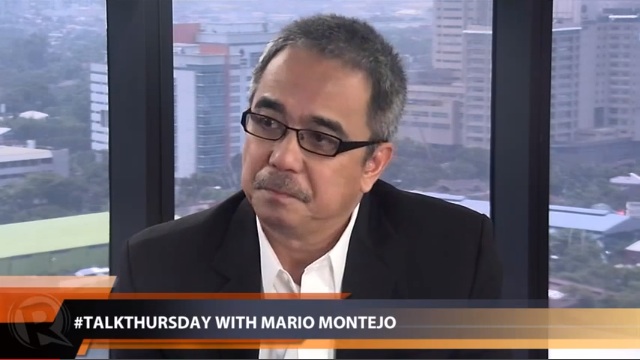SUMMARY
This is AI generated summarization, which may have errors. For context, always refer to the full article.

MANILA, Philippines – Science and technology will be key to competitiveness – and the country is already on its way there, thanks to Filipino innovation.
Speaking on Rappler’s #TalkThursday July 25, Science and Technology Secretary Mario Montejo said many of these technologies and projects are already improving the lives of Filipinos.
The Department of Science and Technology (DOST) is already focusing on harnessing science, technology and innovation to improve the country’s competitiveness, part of the Smarter Philippines initiative, the highlight of the 2013 National Science & Technology Week (NSTW) held in Pasay City from July 23-27.
The focus of these programs, Montejo said, are in agriculture, industry, disaster preparedness, transportation, health, and government services.
“We have started and some of them are already here, some will be next year. We’re excited by the potential roll-outs next year and the years after that,” he said.
The aim is to have projects that are directly useful to the public.
“The first 3 years [of the administration] was really starting [projects], so to speak… [we need] a more direct outcome, a more tangible outcome – meaning outcomes that can be used at the marketplace by the users to improve competitiveness. Even if its direct or applied research, it takes years, so the appreciation of the outcome will come years after,” he said.
One of the DOST’s flagship programs, the National Operational Assessment of Hazards, popularly known as Project NOAH, is already helping many citizens, he said.
Project NOAH, a response to the devastation brought by tropical storm Sendong back in 2011, is expanding beyond giving weather forecasts.
READ: Project NOAH: Advocating a culture of safety
READ: DOST unveils national flood monitoring plan
“What Project NOAH will be presenting is, say 6 hours from now, assuming there might be flood events, the area where there will be flooding, even the depth. People can now appreciate…where the flood will be,” he said.
The DOST is also envisioning NOAH to go beyond disaster preparation and response, particularly for use in climate prediction and agrometeorology, to help people, especially those who are dependent on the weather like farmers and fisherfolk, plan ahead.
Technology for businesses
Technopreneuship is also one of the major thrusts of the DOST. Montejo, himself a technopreneur before joining government, said the department’s Small Enterprise Technology Upgrading Program (SETUP) is helping micro, small, and medium enterprises all over the country to develop and use technology to grow their businesses.
SETUP, Montejo said, has been in existence for the past 10 years, and has supported businesses all over the country through technology transfer, training, and funding.
The return-of-investment rate in the first 3 years of the administration, he said, is at 85%, showing that “using technology can really make your business more viable.”
The challenge now, he said, is to make more people interested in technopreneuship. “We really have to.. make [technopreneurship] popular – that the use of science, technology, and innovation can really be [profitable],” he said.
Connectivity
To maximize all these programs, products, and services, connectivity will play a big role, and Montejo said the DOST is already embarking on programs to achieve this.
“We’re looking at TV white space,” Montejo said. “This is a very cost-effective way at being able to reach out to unserved or underserved areas which don’t have the connectivity.”
The TV White Space Initiative aims to use the unused parts of the television frequency spectrum to provide data connectivity nationwide, with potential in education, environmental sensors, telemedicine, and connectivity in rural areas, according to the department.
READ: TV White Space tech hopes to get more Pinoys connected
The aim is to have 99% of the country connected before the Aquino administration leaves office in 2016, Montejo said.
“All other government services can be made available because of improvement of connectivity, and we’re talking [of] nationwide [connectivity],” he said.
Presidential backing
Another connectivity project, Montejo said, is the e-Gov project, which will harmonize the government’s information systems, in hopes of cutting red tape in the bureaucracy. The project, he said “could really improve… all kinds of government services.”
What the TV whitespace project, and all other DOST initiatives, need will be “a little policy [direction]” and more private collaborators, Montejo said.
READ: Crowdsourcing dengue alert
READ: Robotics? Smarter in the Philippines!
READ: UP, DOST to design cheaper train after test run
A good thing, he said, is that the President is on board. “Our President believes in our technology, and also [in] our Filipno scientists and engineers. With this support, we were able to push ahead with our programs, in spite of apprehension of other people,” he said.
Another key factor will be the Filipino scientists and innovators themselves. Montejo said that as long as their basic needs are fulfilled, they will be more focused on developing technology that will benefit their countrymen.
“By creating [a] kind of environment with programs that will result to improvement of the lives of Filipinos, that’s the most important motivation [for our scientists],” the secretary said.
“I firmly believe that local technology works,” Montejo added. – Rappler.com
Add a comment
How does this make you feel?
There are no comments yet. Add your comment to start the conversation.